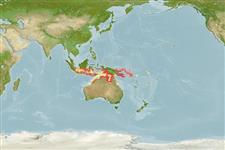Common names from other countries
Environment: milieu / climate zone / depth range / distribution range
Ecologia
marino; acqua dolce; salmastro demersale; pH range: 7.5 - 8.2; dH range: 18 - 30; anadromo. Tropical; 24°C - 32°C (Ref. 2059); 3°S - 19°S
Western Pacific: northern Australia and southern New Guinea.
Size / Peso / Age
Maturity: Lm ? range ? - ? cm
Max length : 60.0 cm SL maschio/sesso non determinato; (Ref. 44894)
Spine dorsali (totale): 1; Raggi dorsali molli (totale): 7; Spine anali 0; Raggi anali molli: 15 - 19
Adults inhabit freshwater rivers and lagoons, as well as brackish estuaries and coastal marine waters. Can tolerate temperatures from 11°C to 38°C. Large groups of juveniles are often encountered (Ref. 44894). Feed on arthropods, insects, aquatic plants, mollusks, prawns, crayfish, fishes and bottom detritus. Nest is constructed among gravel where eggs are deposited forming a mound (Ref. 205). The only species among oral incubating ariids exhibiting no parental care (Ref. 205). Breeding takes place from September to February (Ref. 44894). Marine populations of A. graeffei appear to undertake extensive anadromous migrations associated with breeding, but no such movements were observed in the fluviatile population studied (Ref. 38559).
Life cycle and mating behavior
Maturità | Riproduzione | Deposizione | Uova | Fecundity | Larve
Nest is constructed among gravel where eggs are deposited forming a mound (Ref. 205). The only species among oral incubating Ariidae exhibiting no parental care (Ref. 205).
Allen, G.R., 1989. Freshwater fishes of Australia. T.F.H. Publications, Inc., Neptune City, New Jersey. (Ref. 5259)
IUCN Red List Status (Ref. 130435)
CITES (Ref. 128078)
Not Evaluated
Threat to humans
Traumatogenic (Ref. 58010)
Human uses
Informazioni ulteriori
BibliografiaAcquacolturaProfilo di acquacolturaVarietàGeneticaElectrophoresesEreditarietàMalattieElaborazioneMass conversion
CollaboratoriImmaginiStamps, Coins Misc.SuoniCiguateraVelocitàModalità di nuotoArea branchialeOtolithsCervelliVista
Strumenti
Special reports
Download XML
Fonti Internet
Estimates based on models
Preferred temperature (Ref.
115969): 26.7 - 28.7, mean 27.9 (based on 270 cells).
Phylogenetic diversity index (Ref.
82804): PD
50 = 0.5010 [Uniqueness, from 0.5 = low to 2.0 = high].
Bayesian length-weight: a=0.00813 (0.00384 - 0.01719), b=3.06 (2.88 - 3.24), in cm Total Length, based on LWR estimates for this (Sub)family-body shape (Ref.
93245).
Trophic level (Ref.
69278): 3.6 ±0.2 se; based on diet studies.
Resilienza (Ref.
120179): Medio, tempo minimo di raddoppiamento della popolazione 1.4 - 4.4 anni (Preliminary K or Fecundity.).
Fishing Vulnerability (Ref.
59153): Moderate to high vulnerability (49 of 100).
